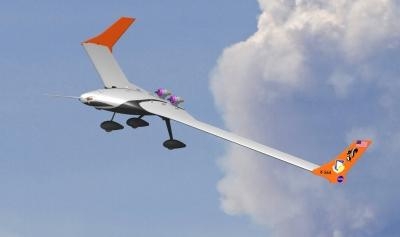Mon, Mar 05, 2012
UAV Will Be Used In Aircraft Configuration Research
The Air Force Research Laboratory was recently awarded an
X-Plane designation for a vehicle that will be used to explore
active control of lightweight, aerodynamically-efficient aircraft
configurations. The X-56A is an innovative, modular, unmanned fight
research vehicle that will allow investigation of active flutter
suppression and gust load alleviation technology.

Flutter is an instability that can occur when unsteady
aerodynamic loads acting on a wing couple with its natural
vibration modes, often resulting in catastrophic failures. The
research to be conducted with the X-56A is critical for the
successful development of future slender, lightweight, high aspect
ratio wing designs that could be used by energy efficient transport
and unmanned aircraft.
The X-56A, also known as the Multi-Utility Technology Testbed
(MUTT) flight demonstrator, is a product of the AFRL-led
Multi-Utility Aeroelastic Demonstration (MAD) program. This program
is a joint effort between AFRL's Air Vehicles Directorate, NASA
Dryden and Lockheed Martin.
The X-56A is powered by twin JetCat P240 turbojets, has a
28-foot wing span, weighs 480 pounds, and is designed and
constructed for easy wing replacement to enable testing of various
flexible wing configurations. An additional hard point is being
designed into the center of aft upper deck of the fuselage for
mounting an additional third engine or a structural member to
support testing of joined wing configurations. These
characteristics will allow the testing of a wide range of advanced
aerodynamic concepts. The X-56A will exhibit multiple rigid body
and aeroelastic instabilities within its flight envelope, which
will be actively managed by its flight control system.
The first X-56A flight is scheduled for summer 2012. Following
Air Force flight testing, the X-56A will be used by NASA's Dryden
Flight Research Center for their continuing research into
lightweight structures and advanced technologies for future
low-emissions transport aircraft.
More News
Airport Marking Aids Markings used on runway and taxiway surfaces to identify a specific runway, a runway threshold, a centerline, a hold line, etc. A runway should be marked in ac>[...]
"It is extremely difficult, if not impossible, for manned aircraft to see a drone while conducting crop-enhancing and other aerial applications at low altitudes and high speeds. We>[...]
Aero Linx: The Skyhawk Association The Skyhawk Association is a non-profit organization founded by former Skyhawk Pilots which is open to anyone with an affinity for the A-4 Skyhaw>[...]
“The T-54A benefits from an active Beechcraft King Air assembly line in Wichita, Kansas, where all required METS avionics and interior modifications are installed on the line>[...]
Aero Linx: Aerostar Owners Association The Association offers the Aerostar Owner a unique opportunity to tap an invaluable source of information concerning the care and feeding of >[...]
 ANN's Daily Aero-Term (04.28.24): Airport Marking Aids
ANN's Daily Aero-Term (04.28.24): Airport Marking Aids Aero-News: Quote of the Day (04.28.24)
Aero-News: Quote of the Day (04.28.24) ANN's Daily Aero-Linx (04.28.24)
ANN's Daily Aero-Linx (04.28.24) Aero-News: Quote of the Day (04.29.24)
Aero-News: Quote of the Day (04.29.24) ANN's Daily Aero-Linx (04.29.24)
ANN's Daily Aero-Linx (04.29.24)



